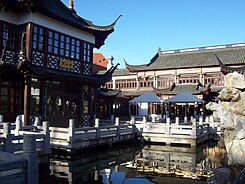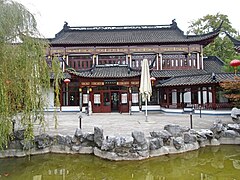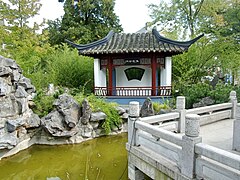Yu Garden
| Yu Garden | |
|---|---|
| Park in Hamburg | |

|
|
| Basic data | |
| place | Hamburg |
| District | Rotherbaum |
| Created | 2008 |
| Surrounding streets | Feldbrunnenstrasse, Binderstrasse |
| Technical specifications | |
| Parking area | 3400 m² |
The Yu Garden is located on Feldbrunnenstrasse in the Rotherbaum district in the immediate vicinity of the Museum for Art and Cultures in the Hamburg-Eimsbüttel district . The ensemble combines Chinese architecture and horticulture according to the principles of Feng Shui on an area of approx. 3400 square meters. The architectural model is the Yu Garden in Shanghai with the Yuyuan tea house from the Ming dynasty and the tea house as the main building.
history
The construction of the facility is based on the city partnership between Shanghai and Hamburg. The declaration to cultivate traditional friendship, to intensify cooperation, to conduct trade, to respect and cultivate the culture of both cities and to exchange information regularly , especially in the areas of economy , science , technology , transport and urban planning , was made in 1986 by the First Mayor Klaus von Dohnanyi and then Lord Mayor of Shanghai and later President Jiang Zemin signed. Every two years, the main topics are recorded in a memorandum . To mark the 20th anniversary of the twinning, some official ceremonies were held in 2006; a Hamburg delegation traveled to China , the Hafen-City got a Shanghai avenue and those responsible decided to set a visible sign of their solidarity in the form of a Chinese center in Hamburg. It should be a center for culture, but also promote tourism between Shanghai and Hamburg. The city of Hamburg provided a piece of land directly at the back of the museum - at that time for ethnology - today MARKK (Museum am Rothenbaum for Art and Cultures). The basis for the use was a heritable building right agreement with which the City of Hamburg gives the Chinese partners the high-quality property of approx. 3400 square meters free of charge for 30 years.
Construction of the Yu Gardens
The construction of the Hamburg-Shanghai-Tourismus-Europa-Zentrum was decided in the 2004 memorandum and a company was commissioned with the planning. A model of the future German-Chinese Center has been in the foyer of the Eimsbüttel district office on Grindelberg since September 2006. The showcase with the model is now in the entrance area of the tea house. After an investor and a company had been found to build it, the foundation stone was laid in November 2007. The materials - mainly pine wood, traditional roof tiles, Taihu stones , furniture and much more from the region there - were packed in over 40 shipping containers and transported to Hamburg. The material and technical competence to build it were a gift to Hamburg. Initially, the ensemble also included a restaurant serving traditional Chinese cuisine. The plant opened in September 2008.
The ensemble
The Yu Garden is located on a hill that can be reached via a few steps on both Binderstraße and Feldbrunnenstraße. A narrow slope without steps is on Binderstrasse. The main entrance is on Feldbrunnenstrasse, recognizable by the large Chinese entrance gate, in front of which are two large stone lions. The larger buildings, the tea house and the tea pavilion are located on the north and west side of the ensemble on two floors and are arranged in an L shape. The large terrace connects the buildings, in front of which there is an artificially created water surface with a waterfall made of Taihu stones. Various small fish and some plants swim in the water. A multi-jagged bridge leads across the water to the outbuilding and the tea house. On the bridge there are small lion statues against evil spirits and decorative ornaments. Narrow sidewalks with symbols lead through the garden and to the smaller garden pavilions. There are two large mosaics in the floor: the yin and yang symbol on the sidewalk in the garden and the crane, which is very important in China. It symbolizes wisdom and a long life and is located in a covered pavilion. On the north side, the property is bounded by a white wall with a corrugated end, there is an entrance and some parking spaces for cars or delivery vehicles. To the west of Binderstraße and at the back of the museum is the entrance to an underground car park with a large free-standing Chinese gate. All buildings, including the small garden pavilions, are marked with symbols. Larger Taihu stones are distributed throughout the garden and in the water, one stone is provided with gold lettering. The garden is open to the street and is separated from the sidewalks by the increased area and vegetation. The outdoor areas can be visited at any time, even if the buildings are locked and no event is taking place. Seating areas in the garden pavilions and on the sidewalks invite visitors to linger.
Events and use of the rooms
In the past, the premises were mainly used by the Confucius Institute of the University of Hamburg. Together with the University of Hamburg Marketing GmbH, which looks after the tea house, mainly language courses and traditional tea ceremonies took place there, but also game afternoons and many courses. The highlights of the year are the traditional Moon Festival and the New Year Festival . Various courses, including for children, could mostly be attended for a fee. This included painting, calligraphy, tea and garden art, but also game afternoons, Shogi tournaments or Qigong, literature evenings, film screenings or concerts. The basis for the maintenance of the plant was a lease agreement between the Chinese builder Shanghai Yu Yuan Tourist Mart Co. Ltd and the Universität Hamburg Marketing GmbH (UHHMG), which was concluded in 2012 for a period of five years. The Confucius Institute is a non-profit organization. One of the institute's set goals is to build a long-term bridge between China and Germany within the “German-Chinese Dialogue” event series. Further tasks are documented in a video that is published in German and Chinese. It was also agreed that the premises can also be used by private persons for celebrations or conferences for a fee.
Reopening after renovation in 2019
When the lease expired, the buildings and the outdoor area were closed and cordoned off with a tape recorder. Weather-related damage - mainly on the roofs - made a complete closure necessary. Repairs inside and outside have now been carried out, the gardens have also been repaired and the pavilions have been given new paintwork. On January 17, 2020 the tea house was officially reopened as part of a festive event and in the presence of the Chinese Consul General Du Xiaohui and Hamburg's Mayor Peter Tschentscher. The restaurant business has now also been resumed.
Web links
- Site of the Confucius Institute of the University of Hamburg
- Confucius Institute of the University of Hamburg Events
- Hamburger China-Gesellschaft e. V. China Nights 2019
- Reopening in 2020, Authority for Culture and Media
literature
- Hans-Wilm Schütte: The Hamburg Yu Garden . Ostasienverlag, September 2017, ISBN 978-3-946114-43-7
Videos
- University of Hamburg Marketing, celebration location Yu Garden Hamburg on YouTube
- Universität Hamburg Marketing, conference location Yu Garden Hamburg on YouTube
Individual evidence
- ↑ a b Reopening of the Chinese tea house "Hamburg Yu Garden". Retrieved September 18, 2019 .
- ↑ Model of the Hamburg - Shanghai Tourism Europe Center. Retrieved September 18, 2019 .
- ^ Laying of the foundation stone - message on Kulturkarte.de. Retrieved September 18, 2019 .
- ↑ a b University of Hamburg Marketing GmbH will look after the Chinese tea house in the future. Retrieved September 18, 2019 .
- ^ The Institute - Confucius Institute at the University of Hamburg. Retrieved October 19, 2019 .
- ↑ Yu Garden Hamburg officially opened. Retrieved January 17, 2020 .
Coordinates: 53 ° 34 ′ 6.5 ″ N , 9 ° 59 ′ 24.8 ″ E





